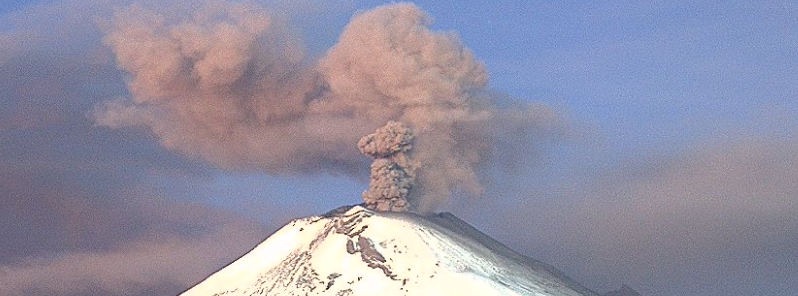Intense activity continues at Popocatepetl volcano, Mexico

Intense activity continues at Mexico's Popocatepetl volcano with 14 explosions on October 2 and two on October 3, 2019.
In 24 hours to 16:00 UTC on October 3, 177 exhalations were detected, accompanied by steam, gas and ash, as well as 434 minutes (7 hours) of tremor and one tectonic earthquake with a magnitude of 2.4.
In addition, two explosions were recorded today at 04:46 and 06:27 LT. The first explosion generated a column of approximately 2 km (6 500 feet) and the second a column of 1 km (3 300 feet). Both explosions threw incandescent fragments on the slopes of the volcano.
According to the country's National Civil Protection Coordination, a yellow phase 2 alert remains in effect – the volcano is displaying signs of elevated unrest above distinguished background activity.





On September 27, with the support of the National Guard, a reconnaissance overflight was made to the Popocatépetl volcano crater.
During this overflight, specialists from CENAPRED and researchers from the Geophysics Institute of UNAM, observed in detail the general conditions of the crater and the presence of a dome 30 m (98 feet)in diameter. Likewise, thermal images and photographs were obtained with which it was possible to determine that the internal crater maintains its same dimensions (350 m / 1 148 feet in diameter and 150 m / 492 feet deep)




People are urged to stay away from the volcano, especially its crater.
Just last month on August 13, Popocatepetl volcano had seven moderate and two major explosions, with 209 exhalations identified and ash to 7 km (23 000 feet).
Geological summary
Volcán Popocatépetl, whose name is the Aztec word for smoking mountain, rises 70 km (44 miles) SE of Mexico City to form North America's 2nd-highest volcano. The glacier-clad stratovolcano contains a steep-walled, 400 x 600 m (1 312 x 1 968 feet) wide crater.
The generally symmetrical volcano is modified by the sharp-peaked Ventorrillo on the NW, a remnant of an earlier volcano.
At least three previous major cones were destroyed by gravitational failure during the Pleistocene, producing massive debris-avalanche deposits covering broad areas to the south. The modern volcano was constructed south of the late-Pleistocene to Holocene El Fraile cone.
Three major plinian eruptions, the most recent of which took place about 800 CE, have occurred from Popocatépetl since the mid Holocene, accompanied by pyroclastic flows and voluminous lahars that swept basins below the volcano. Frequent historical eruptions, first recorded in Aztec codices, have occurred since precolumbian time. (GVP)
Featured image credit: CENAPRED

Commenting rules and guidelines
We value the thoughts and opinions of our readers and welcome healthy discussions on our website. In order to maintain a respectful and positive community, we ask that all commenters follow these rules:
We reserve the right to remove any comments that violate these rules. By commenting on our website, you agree to abide by these guidelines. Thank you for helping to create a positive and welcoming environment for all.